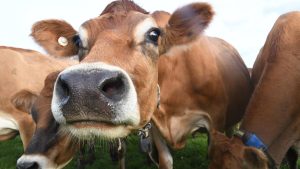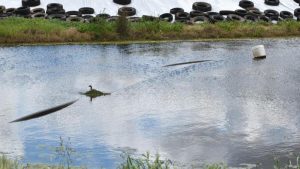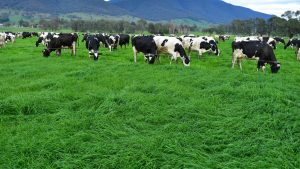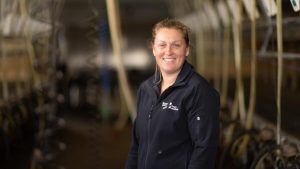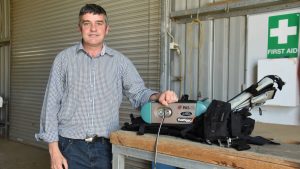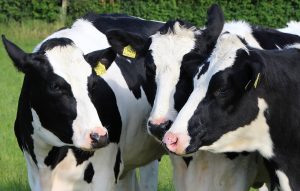
Partial mixed ration dairy systems are becoming more common throughout Australia and challenges remain around identifying how to ensure these systems remain profitable. Maximising pasture intake in PMR farms is likely to reduce feed-related costs. Recent research has identified that high pasture intakes in PMR systems can only be achieved by offering cows large quantities of high-quality pasture.
Intake
In most intensive grazing scenarios, cows are offered a strip of pasture each day with a limited amount of high quality, highly digestible pasture available for consumption.
Specifically, the high-quality part of pasture is the leafy material. Cows will selectively remove this leafy section of pasture across the entire area of a pasture strip before they regraze areas and start to consume the lower quality stemmy portion of the pasture sward.
Offering cows small allocations of pasture forces cows to graze down into the stem, where the pasture is less digestible and takes longer to break down in the rumen, reducing intake.
In PMR systems, intake is driven by both pasture and mixed ration quality. Understanding the interaction between both feed sources is vital to ensure diets are balanced and meet herd demands to maintain production targets.
The C4Milk team at the Gatton Research Dairy in south-east Queensland investigated the effect of lucerne pasture height (at very high, unlimited allocations) and mixed ration level on total dry matter intake. Lucerne pastures should be grazed at a minimum of 39 centimetres above ground level to maximise intake, irrespective of the amount of PMR offered.
Cows consistently grazed the top 12-14cm of pasture (leafy section), and for every 10cm increase in pasture height, total intake increased by 3.4 and 1.7 kg dry matter per day for high (14 kg DM/day) and low (7 kg DM/day) mixed ration levels respectively (see Figure 1).
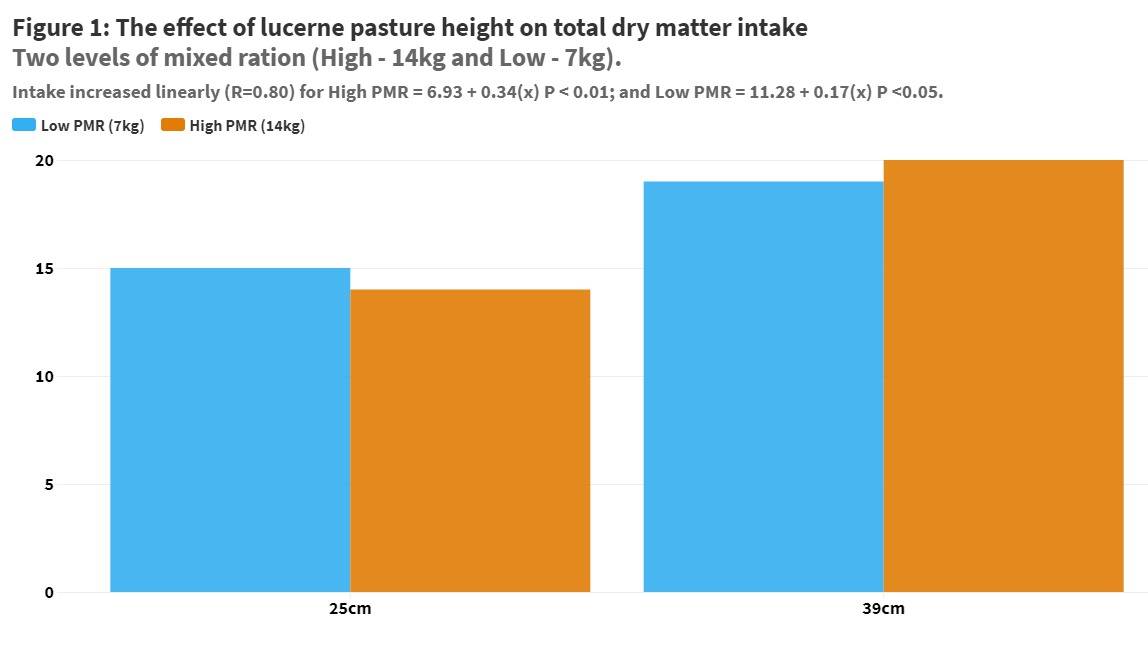
The increase in intake was likely driven by a higher bite mass as pasture height increased. In legume pastures, the bulk density of leafy material in the top the plant increases as pasture height increases, which explains why cows were able to consume more pasture per bite.
In this study, lucerne pasture was offered to cows in large volumes (high allocations) to ensure that cows only grazed across the area of the paddock once, and were only consuming the top leafy section of the pasture.
Feeding strategy
This work has identified two key outcomes to ensure pasture and total intake is maximised in PMR dairy systems.
Firstly, irrespective of the total proportion of pasture in the diet, lucerne should be offered to cows at no less than 39cm, with a large enough area to ensure that cows can selectively remove the leafy material.
Secondly, mixed rations within the PMR diet are formulated to achieve the targeted total dry matter and nutrient intakes when combined with the intake and quality of the consumed pasture.
Grazing management
Once the pasture reaches the targeted pre-grazing height, estimate the amount of leafy pasture on offer per hectare (about approximately the top13 cm), typically 1000kg DM/ha for lucerne. Using this value allocate the appropriate area for the herd and check if the allocation is correct by visually assessing the paddock.
Cows will selectively remove the leafy material across the area of the paddock but will avoid grazing areas contaminated with faeces. If there is a small area (less than 5 per cent) of the paddock ungrazed, the allocation is correct. However, if the entire paddock has been grazed, including around faecal patches the allocation was too small.
The management of the residual should aim to reduce the pasture back to the optimum height to maintain plant density and longevity of the sward. This can be achieved by following the milking herd with a lower class stock or by mechanically removing the residual pasture. Following the herd with a lower class stock such as heifers or dry cows ensures that the utilisation of pasture is maximised without compromising intake and production of the milking herd by forcing them to graze down into the stem.
Using this strategy to graze lucerne within a PMR system will:
Maximise DMI, diet quality and milk production.
Reduce diet-related costs in PMR systems by offsetting expensive concentrates with high-quality pasture.
Achieve high levels of pasture utilisation when managing residuals with secondary stock.
This work was carried out by the C4Milk team at the Gatton Research Dairy as part of the C4Milk feedbase management research, development and extension project funded by farmer levies through Dairy Australia. This project is supported by the Queensland Government through in-kind financial support of salaries for the project team and has a long-term commitment to supporting the northern dairy industry to improve its profitability and resilience.
*Kieran Ison was part of the 2020 Australian Dairy Conference’s Young Dairy Scientist Award competition. This is an edited version of the article he submitted as part of that competition.






